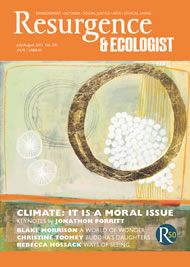John Muir was born into an austere Scottish Christian home where scripture and the teachings of God were drummed into his young mind. Nature was his passion, however, and on moving in 1849 to a new life in Wisconsin, the 11-year-old Muir found a land that, although beginning to feel the hand of humans, still had rich wetlands, expansive natural forests and vast flocks of Passenger Pigeons.
All this was subject to rapid change. As Muir matured and began to take a more focused interest in Nature, he would witness the acceleration in the damage caused by people to natural areas and wildlife.
Muir’s wanderings in the wilderness took him to some of the wildest parts of North America. As well as travelling and writing, he made meticulous observations and was one of the first to fully appreciate the profound role played by glaciers in shaping landscapes. Mary Colwell writes about what he saw: “Towns and villages sat directly on top of moraines that seemed as fresh as the day they were deposited. Gardens were planted around smooth ice-polished boulders. Scratches on rocks from the sandpaper effect of stones embedded in the ice were so fresh that it seemed the glacier had not long melted. Here was a landscape just breathing again after millennia entombed in ice.”
Muir’s experiences led to a vast literature of articles, a number of books, and then his reincarnation as an advocate for Nature. His time in the wilderness enabled him to be an authentic and influential campaigner, to be the first president of the Sierra Club and to famously guide Theodore Roosevelt through the Yosemite Valley, in the process planting seeds that would emerge as major presidential interventions to protect America’s finest natural areas.
Like the relatively few conservationists before him, and the many who have followed, Muir was driven by a deep affinity with Nature. And, like most others who feel connections with the natural world, he discovered the pain and frustration that arose from the mindless, dollar-driven destruction that he saw nearly everywhere he went. On the matter of shooting migrating birds to eat, he wrote: “Song birds for food! Compared with this, making kindling of pianos and violins would be pious economy.”
Making the transition from naturalist to frustrated observer of human behaviour and ignorance, and from there to conservationist took Muir on a journey familiar to many modern advocates. From 1906 he played a prominent role in a campaign to spare the Hetch Hetchy Valley outside San Francisco from being dammed and flooded to supply the recently earthquake- and fire-ravaged city with water. In speaking up for the plants, animals and spectacular scenery there, he was portrayed as anti-progress, with the city engineer dismissing what he called the preservationists as a bunch of “short-haired women and long-haired men”.
On reading this excellent book I was struck by the resonance with some aspects of the modern conservation debate and the desirability of making the case for protecting Nature from people, compared with the idea of looking after Nature so it can sustain the people. In this book we are reminded that protecting Nature for practical human-centric reasons, as well as ethical and spiritual ones, was a successful strategy more than a century ago and one reason why President Theodore Roosevelt felt able to protect so much of America – for the people.
This engaging portrait of Muir reminds us that it’s not either/or, but how successful conservation strategies can embrace more than one case at a time, with Nature for the people a powerful argument to be deployed alongside Nature for its own sake. Striking also is Muir’s view about the vital importance of getting people into the wild places as a vital prerequisite for saving them.
Colwell has done a fine job in charting the life of one of Nature’s greatest heroes.






